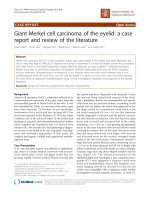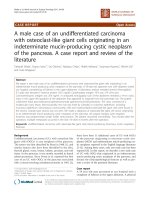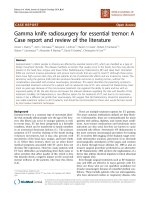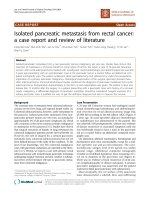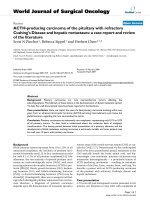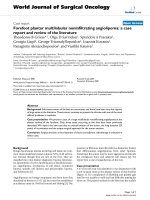Báo cáo khoa học: "Adrenocortical oncocytic carcinoma with recurrent metastases: a case report and review of the literature" ppt
Bạn đang xem bản rút gọn của tài liệu. Xem và tải ngay bản đầy đủ của tài liệu tại đây (869.43 KB, 6 trang )
BioMed Central
Page 1 of 6
(page number not for citation purposes)
World Journal of Surgical Oncology
Open Access
Review
Adrenocortical oncocytic carcinoma with recurrent metastases: a
case report and review of the literature
Pinelopi Argyriou*
1
, Charalambos Zisis
2
, Nektarios Alevizopoulos
3
,
Emmanuel M Kefaloyannis
2
, Constantine Gennatas
4
and
Constantina D Petraki
1
Address:
1
Department of Pathology, Evangelismos General Hospital, Ipsilantou Str., Athens, Greece,
2
Department of Thoracic and Vascular
Surgery, Evangelismos General Hospital, Ipsilantou Str., Athens, Greece,
3
Oncology Clinic, Evangelismos General Hospital, Ipsilantou Str., Athens,
Greece and
4
Oncology Clinic, Areteion Hospital, University of Athens, Vas. Sofias Av., Athens-Greece
Email: Pinelopi Argyriou* - ; Charalambos Zisis - ; Nektarios Alevizopoulos - ;
Emmanuel M Kefaloyannis - ; Constantine Gennatas - ;
Constantina D Petraki -
* Corresponding author
Abstract
Background: Adrenal cortex oncocytic carcinoma (AOC) represents an exceptional pathological
entity, since only 22 cases have been documented in the literature so far.
Case presentation: Our case concerns a 54-year-old man with past medical history of right
adrenal excision with partial hepatectomy, due to an adrenocortical carcinoma. The patient was
admitted in our hospital to undergo surgical resection of a left lung mass newly detected on chest
Computed Tomography scan. The histological and immunohistochemical study revealed a
metastatic AOC. Although the patient was given mitotane orally in adjuvant basis, he experienced
relapse with multiple metastases in the thorax twice in the next year and was treated with
consecutive resections. Two and a half years later, a right hip joint metastasis was found and
concurrent chemoradiation was given. Finally, approximately five years post disease onset, the
patient died due to massive metastatic disease. A thorough review of AOC and particularly all
diagnostic difficulties are extensively stated.
Conclusion: Histological classification of adrenocortical oncocytic tumours has been so far a
matter of debate. There is no officially established histological scoring system regarding these rare
neoplasms and therefore many diagnostic difficulties occur for pathologists.
Background
Hamperl introduced the term "oncocyte" in 1931 refer-
ring to a cell with abundant, granular, eosinophilic cyto-
plasm [1]. Electron microscopic studies revealed that this
granularity was due to mitochondria accumulation in the
oncocyte cytoplasm [2]. Neoplasms composed predomi-
nantly or exclusively of this kind of cells are called "onco-
cytic" [2]. Such tumours have been described in the
overwhelming majority of organs: kidney, thyroid and
pituitary gland, salivary, adrenal, parathyroid and lac-
rimal glands, paraganglia, respiratory tract, paranasal
sinuses and pleura, liver, pancreatobiliary system, stom-
Published: 17 December 2008
World Journal of Surgical Oncology 2008, 6:134 doi:10.1186/1477-7819-6-134
Received: 1 April 2008
Accepted: 17 December 2008
This article is available from: />© 2008 Argyriou et al; licensee BioMed Central Ltd.
This is an Open Access article distributed under the terms of the Creative Commons Attribution License ( />),
which permits unrestricted use, distribution, and reproduction in any medium, provided the original work is properly cited.
World Journal of Surgical Oncology 2008, 6:134 />Page 2 of 6
(page number not for citation purposes)
ach, colon and rectum, central nervous system, female
and male genital tracts, skin and soft tissues [2-15]. Adren-
ocortical oncocytic neoplasms (AONs) represent unusual
lesions and three histological categories are included:
oncocytoma (AO), oncocytic neoplasm of uncertain
malignant potential (AONUMP) and oncocytic carci-
noma (AOC) [3]. In our study, we add to the 22 cases
found in the literature a new AOC with peculiar clinical
presentation [16-29].
Case presentation
A 54-year-old man was admitted in the Thoracic and Vas-
cular Surgery Department of our hospital with a 2 cm
mass at the upper lobe of the left lung detected on Com-
puted Tomography (CT) scan to undergo complete surgi-
cal resection. He had a past medical history of
adrenocortical carcinoma (AC) treated surgically with
right adrenalectomy and partial hepatectomy en block 2
years ago (Figure 1). He was a mild 3 pack year smoker
and a moderate drinker (1/2 kgr wine/day).
Overall physical examination showed neither specific
abnormality, nor any signs of endocrinopathy. All labora-
tory tests including cortisol, 17-ketosteroids and 17-
hydrocorticosteroids serum levels and dexamethasone
test, full blood count and complete biochemical hepatic
plus renal function tests were in normal rates. The patient
was subjected to wedge resection. Histological examina-
tion revealed a tumour with an oxyphilic cell population,
moderate nuclear atypia, diffuse, rosette-like and papil-
lary growth pattern and focal necroses (Figure 2a, b). A
number of 4 mitotic figures/50 high power fields (HPFs)
were documented. The proliferative index Ki-67 (MIB-1,
1:50, DAKO) was in a value range of 10–20% and p53
oncoprotein (DO-7, 1:20, DAKO) was weakly expressed
in a few cells. Immunohistochemical examination
revealed positivity for Vimentin (V9, 1:2000, DAKO),
Melan-A (A103, 1:40, DAKO), Calretinin with a fried-egg-
like specific staining pattern (Rabbit anti-human polyclo-
nal antibody, 1:150, DAKO) and Synaptophysin (SY38,
1:20, DAKO). Both Cytokeratins CK8,18 (UCD/PR 10.11,
1:80, ZYMED) and AE1/AE3 (MNF116, 1:100, DAKO)
showed a dot-like paranuclear expression. Inhibin-a (R1,
1:40, SEROTEC) and CD56 (123C3, 1:50, ZYMED) were
expressed focally (Figures 2c, d and 3a–d). CK7 (OV-TL
12/30, 1:60, DAKO), CK20 (K
S
20.8, 1:20, DAKO), EMA
(E29, 1:50, DAKO), CEAm (12-140-10, 1:50, NOVOCAS-
TRA), CEAp (Rabbit anti-human polyclonal antibody,
1:4000, DAKO), TTF-1 (8G7G3/1 1:40, ZYMED), Chrom-
ogranin (DAK-A3, 1:20, DAKO) and S-100 (Rabbit anti-
human polyclonal antibody, 1:1000, DAKO) were nega-
tive. Based on the morphological and immunohistochem-
ical features of the neoplasm and the patient's past
medical history, other oncocytic tumours were excluded
and the diagnosis of a metastatic AOC was supported.
Mitotane oral medication was given in adjuvant setting (2
g/d).
Seven months later, a new right lower lobe mass of 1.5 cm
diameter was found on follow-up CT scan. A second
wedge resection was performed including an excision of a
Abdominal MRI showing the hepatic invasion, which was sub-mitted to en block resection with the right adrenalFigure 1
Abdominal MRI showing the hepatic invasion, which
was submitted to en block resection with the right
adrenal.
A&B) Oncocytic adrenocortical carcinomaFigure 2
A&B) Oncocytic adrenocortical carcinoma (A-H,
magnification×200). Diffuse (A) and papillary (B) histologi-
cal pattern. C) Vimentin immunohistochemical
expression (magnification ×200). D) Melan-A immu-
nohistochemical expression (magnification ×200).
World Journal of Surgical Oncology 2008, 6:134 />Page 3 of 6
(page number not for citation purposes)
nodule infiltrating the diaphragm. The histopathological
examination confirmed diagnosis of AOC.
A new CT scan, six months later, demonstrated a lobu-
lated mass, 2.8 cm in diameter, at the lingula and a lymph
node block, measuring 11 × 5.5 cm at the preaortic space
extending to the aortopulmonary window (Figure 4). The
patient underwent a left upper lobectomy and radical
mediastinal lymph node dissection. Histological exami-
nation confirmed AOC relapse with neoplastic spread
around the superior lobar bronchus, invasion into
branches of the pulmonary artery and metastatic infiltra-
tion of peribronchial and mediastinal lymph nodes.
Three and a half years post first surgery, a right hip joint
metastasis was revealed on CT scan (Figure 5). The patient
received three cycles of cisplatin based chemotherapy (75
mg/m
2
q 21 days) followed by three cycles of epirubicin
(50 mg/m
2
q 21 days) and etoposide (100 mg/m
2
D1, D2,
D3 q 21 days) combined chemotherapeutic regiments,
concurrently with radiotherapy of right hip. No severe
toxicity was stated. The therapeutic schedule combination
with ongoing, orally given, mitotane was completed une-
ventfully. The patient remained in a good performance
status (PS: 0) for 16 months and finally died, approxi-
mately 5 years post his disease onset, due to massive recur-
rence.
Discussion
Adrenocortical tumours are usually solitary lesions and in
their vast majority occur in adults without sex predilection
[4]. Several histological systems have been proposed so far
in a trial to predict the biological behaviour of these neo-
plasms [30-35]. Among them the Weiss system has the
most important position and is widely used. This system
supports that the presence of four or more of the follow-
ing nine criteria (nuclear grade III-IV, mitotic rate >5/50
HPFs, atypical mitoses, clear cell tumour composition ≤
25%, diffuse architecture, necrosis, venous, sinusoidal
and capsular invasion) is indicative of malignancy. An
increased number of mitoses, especially when combined
with atypical forms, and venous invasion were best asso-
A) Calretinin immunohistochemical expression (magnifica-tion ×200)Figure 3
A) Calretinin immunohistochemical expression
(magnification ×200). Fried-egg-like specific staining pat-
tern. B) CK8-18 immunohistochemical expression
(magnification ×200). Dot-like paranuclear expression. C)
CD56 immunohistochemical expression (magnifica-
tion ×200). D) Synaptophysin immunohistochemical
expression (magnification ×200).
Chest CT-scan revealing the sizeable mediastinal mass in the pre-aortic space extending into the aortopulmonary windowFigure 4
Chest CT-scan revealing the sizeable mediastinal
mass in the pre-aortic space extending into the aor-
topulmonary window.
Metastatic appearance of the right hipFigure 5
Metastatic appearance of the right hip.
World Journal of Surgical Oncology 2008, 6:134 />Page 4 of 6
(page number not for citation purposes)
ciated with malignancy [31]. The presence of more than
20 mitoses was correlated with more adverse clinical out-
come and ACs with this criterion was suggested to be des-
ignated high grade [33].
Oncocytic variants of adrenocortical neoplasms are a spe-
cial subgroup and whether the Weiss system can be used
to evaluate their clinical behaviour is under consideration
by several authors [18,22,24,25,36]. Lin et al believed that
the assessment of AOCs should be conservative in the
cases where mitotic activity, necrosis, capsular or vascular
invasion are absent [36]. Furthermore, Krishnamurthy et
al share similar opinion suggesting that the only unques-
tionable criterion of malignancy in an AON is the pres-
ence of metastasis or invasion (capsular and/or vascular)
[18]. Hoang et al. added to the previous malignant fea-
tures the presence of surgical unresectability and large
tumour size [22]. Song et al. also agreed on the modifica-
tion of the Weiss system [25].
More recently, Bisceglia et al. proposed new Weiss modi-
fied criteria and clearly determined the terms AO, AON-
UMP and AOC. More specifically, they suggested the
following: a) if one of the criteria defined as major [high
mitotic rate (>5 mitoses/50 HPF), atypical mitoses,
venous invasion] is present in an AON, the latter should
be considered malignant, b) if one to four of the criteria
defined as minor [large size and/or huge weight (>10 cm
and/or >200 gr), necrosis, capsular invasion, sinusoidal
invasion] is found, the tumour should be deemed of
uncertain malignant potential, and finally c) lack of both
major and minor criteria indicates a benign lesion [24].
The role of the proliferative index (Ki-67) and oncopro-
tein p53 has also been a controversial issue in the past
years. Some authors have suggested that these markers
could be used as potential indicators of the benign or
malignant nature of ACs [37-39]. Bisceglia et al results
concerning Ki-67 expression of AONs were mostly in
accordance with previous studies of the proliferative index
in conventional ACs [24]. However, other authors studies
showed that Ki-67 as long as p53 cannot be reliably used
to predict the biological behaviour of AONs
[18,22,25,36].
Literature review revealed 22 cases of AOC so far [16-29].
All data related to this histological subtype's clinical pres-
entation, pathological fearures, outcome and therapeutic
treatment approaches were studied. We tried to match
them with our case data and furthermore to compare
them to conventional ACs'. AOCs occur in adults between
25 and 77 years and no sex distribution is documented. In
contrast with AOCs, ACs affect both children and adult
population (range cited 43–67 years) and a female predi-
lection is mentioned [40,41]. Histologically, AOCs differ
from conventional ACs as they consist exclusively or pre-
dominantly of oncocytes; however the immunohisto-
chemical profile of both neoplasms is similar. Patients
with AOCs usually present with symptoms regarding
abdominal mass and rarely regarding adrenal hormone
imbalance production [16,17,22,23,25,26,28]. Further-
more, abnormal adrenal hormonal serum and urinary lev-
els, without clinically suspected disease, have been noted
in a few cases [23,24,26,27]. On the other hand, ACs usu-
ally present with high clinical evidence of adrenal hormo-
nal hypersecretion (in 40–60% of cases) and less
frequently with abdominal discomfort or back pain
[41,42]. Literature data show that although invasion of
other organs/structures beyond the primary tumour site
and metastases may be found in both AOCs and ACs at
the onset and/or later on, locally advanced disease does
not occur in AOCs as often as in ACs on first diagnosis
[16,19,22-27,29,41].
In our case, based on the exclusively oncocytic cell fea-
tures of the neoplasm, a differential diagnosis among
oncocytic tumours, either primary of the lung or meta-
static, was needed. The patient's medical history and the
neoplasm's immunohistochemical profile clarified its
adrenocortical origin, its local infiltrative presentation
and its malignant metastatic behaviour.
There is a wide discussion about the multimodality thera-
peutic approach which is needed apart from the radical
surgical excision of the primary AC tumour, its local recur-
rences and relevant metastatic involved sites [42,43].
Radiotherapy, in adjuvant or symptomatic control setting
seems to be delivered helpfully or as a standard care of
palliation [42]. In clinical trials, metastatic AC extensive
disease is treated with mitotane and multiple chemother-
apeutic regiments combination (i.e. etoposide, doxoru-
bicin, cisplatin or streptozotocin). Chemotherapy in
adjuvant setting is under discussion so far [43]. The main-
stay therapeutic approach in both ACs and AOCs is wide
surgical resection. In AOCs, radiotherapy, mitotane and/
or chemotherapy is given individually post bulky cyto-
massive excision, depending on disease staging and pre-
dominant symptoms. Our patient was treated according
to the multimodality therapeutic combination.
It is the first time, in our knowledge, that an AOC was sub-
mitted to consecutive resections due to metastatic infiltra-
tion of both lungs and mediastinal lymph nodes, as if it
was a primary lung cancer. In our case, neoplasm spread-
ing may originate in carcinomatous emboli that entered
the inferior vena cava; however, lymph node invasion has
not been previously described at such a distant site. It is
noteworthy that although this neoplasm had aggressive
behaviour with constant relapse, the patient's perform-
World Journal of Surgical Oncology 2008, 6:134 />Page 5 of 6
(page number not for citation purposes)
ance status remained well. This fact dictated the aggressive
surgical practice.
Conclusion
Histological classification of adrenocortical oncocytic
tumours has been so far a matter of debate. There is no
officially established histological scoring system regarding
these rare neoplasms and therefore many diagnostic diffi-
culties occur for pathologists. Metastatic disease is the
only definite criterion of malignancy. Molecular biology
and large clinical studies may probably provide in the
future more precise criteria for the classification, clinical
behaviour and therapeutic approach of AOCs.
Abbreviations
AC: Adrenocortical Carcinoma; AO: Adrenocortical Onco-
cytoma; AOC: Adrenocortical Oncocytic Carcinoma;
AON: Adrenocortical Oncocytic Neoplasm; AONUMP:
Adrenocortical Oncocytic Neoplasm of Uncertain Malig-
nant Potential; CT scan: Computed Tomography scan;
HPF: High Power Field.
Consent
Written informed consent was obtained from the patient's
relatives for publication of this case report and the accom-
panying images. A copy of the written consent is available
for review by the Editor- in-Chief of this journal.
Competing interests
The authors declare that they have no competing interests.
Authors' contributions
PA did the macroscopic and microscopic examination of
the specimens, collected and reviewed the literature data,
prepared the figures, drafted, wrote, typed, formatted and
revised the manuscript. CDP did the macroscopic and
microscopic examination of the specimens, put the diag-
nosis, made the design, revised and supervised the manu-
script. CZ operated on the patient, participated in the
literature review and drafted the case presentation apart
from the histopathological part. NA elaborated and
revised the manuscript critically for stylistic imperfec-
tions, participated in the literature review and wrote the
part of the manuscript regarding therapy approach. EMK
operated on the patient, collected clinical data and partic-
ipated in the literature review. CG was the attending
oncologist, provided relevant clinical information and
participated in the literature review.
References
1. Hamperl H: Beiträge zur normalen und pathologischen histo-
logic menschlicher speicheldrusen. Z Microanat Forsch 1931,
27:1.
2. Chang A, Harawi SJ: Oncocytes, oncocytosis and oncocytic
tumours. Pathol Annu 1992, 27:263-304.
3. Baloch ZW, LiVolsi VA: Oncocytic lesions of the neuroendo-
crine system. Semin Diagn Pathol 1999, 16:190-199.
4. Rosai J: Rosai and Ackerman's Surgical Pathology Mosby: Elsevier Inc;
2004.
5. Sironi M, Spinelli M: Oncocytic angiomyolipoma of the kidney:
a case report. Int J Surg Pathol 2003, 11:229-234.
6. Ritter JH, Nappi O: Oxyphilic proliferations of the respiratory
tract and paranasal sinuses. Semin Diagn Pathol 1999, 16:105-116.
7. Sugihara A, Nakasho K, Ikuta S, Aihara T, Kawai T, Iida H, Yoshie H,
Yasui C, Mitsunobu M, Kishi K, Mori T, Yamada N, Yamanegi K,
Ohyama H, Terada N, Ohike N, Morohoshi T, Yamanaka N: Onco-
cytic non-functioning endocrine tumor of the pancreas.
Pathol Int 2006, 56:755-759.
8. Radi MJ, Fenoglio-Preiser CM, Chiffelle T: Functioning oncocytic
islet-cell carcinoma. Report of a case with electron-micro-
scopic and immunohistochemical confirmation. Am J Surg
Pathol 1985, 9:517-524.
9. Itatsu K, Fujii T, Sasaki M, Zen Y, Nakanuma Y: Intraductal papil-
lary cholangiocarcinoma and atypical biliary epithelial
lesions confused with intrabiliary extension of metastatic
colorectal carcinoma. Hepatogastroenterology 2007, 54:677-680.
10. Rouzbahman M, Serra S, Chetty R: Rectal adenocarcinoma with
oncocytic features: possible relationship with preoperative
chemoradiotherapy. J Clin Pathol 2006, 59:1039-1043.
11. Piana S, Asioli S, Foroni M: Oncocytic adenocarcinoma of the
rectum arising on a villous adenoma with oncocytic features.
Virchows Arch 2006, 448:228-231.
12. Giangaspero F, Cenacchi G: Oncocytic and granular cell neo-
plasms of the central nervous system and pituitary gland.
Semin Diagn Pathol
1999, 16:91-97.
13. Young RH, Scully RE: Oxyphilic tumours of the female and male
genital tracts. Semin Diagn Pathol 1999, 16:146-161.
14. Vancura RW, Thomas JH, Jewell WR, Damjanov I: Bilateral onco-
cytic malignant melanoma in axillary lymph nodes without
evidence of an extranodal primary. Ultrastruct Pathol 2005,
29:399-404.
15. Coburn V, Radfar A, Snook D, Mahalingam M: Cutaneous oncocy-
toma – a report of three cases and review of the literature. J
Cutan Pathol 2007, 34:355-359.
16. El-Naggar AK, Evans DB, Mackay B: Oncocytic adrenal cortical
carcinoma. Ultrastruct Pathol 1991, 15:549-556.
17. Alexander A, Paulose KP: Oncocytic variant of adrenal carci-
noma presenting as Cushing's syndrome. J Assoc Physicians India
1999, 47(3):351-352.
18. Krishnamurthy S, Ordonez NG, Shelton TO, Ayala AG, Sneige N:
Fine-needle aspiration cytology of a case of oncocytic adren-
ocortical carcinoma. Diagn Cytopathol 2000, 22:299-303.
19. Kurek R, Von Knobloch R, Feek U, Heidenreich A, Hofmann R: Local
recurrence of an oncocytic adrenocortical carinoma with
ovary metastasis. J Urol 2001, 166:985.
20. Lázaro Santander R, Andrés Gozalbo C, Cortés Vizcaíno V, Vera
Román JM: [Low-grade oncocytic adrenal carcinoma]. Arch Esp
Urol 2001, 54:1123-1126.
21. Wu SL, Biddle DA, Ordonez NG, Krishnamurthy S, Ayala AG, Ro JY:
Oncocytic adrenocortical neoplasms: A clinicopathologic
and immunohistochemical study of seven cases [abstract].
Mod Pathol 2002, 15:121A.
22. Hoang MP, Ayala AG, Albores-Saavedra J: Oncocytic adrenocorti-
cal carcinoma: a morphologic, immunohistochemical and
ultrastructural study of four cases. Mod Pathol 2002,
15:973-978.
23. Tanaka K, Kumano Y, Kanomata N, Takeda M, Hara I, Fujisawa M,
Kawabata G, Kamidono S: Oncocytic adrenocortical carcinoma.
Urology 2004, 64(2):376-377.
24. Bisceglia M, Ludovico O, Di Mattia A, Ben-Dor D, Sandbank J, Pas-
quinelli G, Lau SK, Weiss LM: Adrenocortical oncocytic tumors:
Report of 10 cases and review of the literature. Int J Surg Pathol
2004, 12:231-243.
25. Song SY, Park S, Kim SR, Suh YL: Oncocytic adrenocortical car-
cinomas: a pathological and immunohistochemical study of
four cases in comparison with conventional adrenocortical
carcinomas. Pathol Int 2004, 54:603-610.
26. Gołkowski F, Buziak-Bereza M, Huszno B, Bałdys-
Waligórska A, Stefańska A, Budzyński A,
Okoń K, Chrzan R, Urbanik A: The unique case of adren-
ocortical malignant and functioning oncocytic tumour. Exp
Clin Endocrinol Diabetes 2007, 115:401-404.
Publish with BioMed Central and every
scientist can read your work free of charge
"BioMed Central will be the most significant development for
disseminating the results of biomedical research in our lifetime."
Sir Paul Nurse, Cancer Research UK
Your research papers will be:
available free of charge to the entire biomedical community
peer reviewed and published immediately upon acceptance
cited in PubMed and archived on PubMed Central
yours — you keep the copyright
Submit your manuscript here:
/>BioMedcentral
World Journal of Surgical Oncology 2008, 6:134 />Page 6 of 6
(page number not for citation purposes)
27. Padberg BC, Rordorf T, Suter SL, Pfeiffer D, Wild D, Schröder S:
[
123
I-Metaiodobenzylguanidine- (MIBG-) scintigraphy: para-
doxical positivity in an oncocytic adrenocortical carcinoma].
Pathologe 2007, 28:281-284.
28. Ali AE, Raphael SJ: Functional oncocytic adrenocortical carci-
noma. Endocr Pathol 2007, 18:187-189.
29. Juliano JJ, Cody RL, Suh JH: Metastatic adrenocortical oncocy-
toma: a case report. Urol Oncol 2008, 26:198-201.
30. Hough AJ, Hollifield JW, Page DL, Hartmann WH: Prognostic fac-
tors in adrenal cortical tumors. A mathematical analysis of
clinical and morphologic data. Am J Clin Pathol 1979, 72:390-399.
31. Weiss LM: Comparative histologic study of 43 metastasizing
and nonmetastasizing adrenocoritcal tumors. Am J Surg Pathol
1984, 8:163-169.
32. Van Slooten H, Schaberg A, Smeenk D, Moolenaar AJ: Morphologic
characteristics of benign and malignant adrenocortical
tumors. Cancer 1985, 55:766-773.
33. Weiss LM, Medeiros LJ, Vickery AL Jr: Pathologic features of
prognostic significance in adrenocortical carcinoma. Am J
Surg Pathol 1989, 13:202-206.
34. Medeiros LJ, Weiss LM: New developments in the pathologic
diagnosis of adrenal cortical neoplasms. A review. Am J Clin
Pathol 1992, 97:73-83.
35. Medeiros LJ, Weiss LM: Adrenal gland: Tumors and tumor-like
lesions. In The difficult diagnosis in surgical pathology Edited by: Wei-
dner N. Philadelphia: WB Saunders; 1996:377-407.
36. Lin BT-Y, Bonsib SM, Mierau GW, Weiss LM, Medeiros LJ: Onco-
cytic adrenocortical neoplasms. A report of seven cases and
review of the literature. Am J Surg Pathol 1998, 22:603-614.
37. Goldblum JR, Shannon R, Kaldjian EP, Thiny M, Davenport R, Thomp-
son N, Lloyd RV: Immunohistochemical assessment of prolif-
erative activity in adrenocortical neoplasms. Mod Pathol 1993,
6:663-668.
38. Vargas MP, Vargas HI, Kleiner DE, Merino MJ: Adrenocortical neo-
plasms: role of prognostic markers MIB-1, p53 and RB.
Am J
Surg Pathol 1997, 21:556-562.
39. Winston JS, Mompoint A, Wang H, Crossland D: The utility of Ki-
67 in the evaluation of adrenocortical neoplasms [abstract].
Mod Pathol 1997, 10:52A.
40. Kirschner LS: Emerging Treatment Strategies for Adrenocor-
tical Carcinoma: A New hope. J Clin Endocrinol Metab 2006,
91:14-21.
41. Bilimoria KY, Shen WT, Elaraj D, Bentrem DJ, Winchester DJ, Kebe-
bew E, Sturgeon C: Adrenocortical Carcinoma in the United
States: Treatment Utilization and Prognostic Factors. Can-
cer 2008, 113:3130-3136.
42. Allolio B, Fassnacht M: Clinical review: Adrenocortical carci-
noma: clinical update. J Clin Endocrinol Metab 2006, 91:2027-2037.
43. Van Ditzhuijsen CIM, van de Weijer R, Haak HR: Adrenocortical
carcinoma. Neth J Med 2007, 65:55-60.

